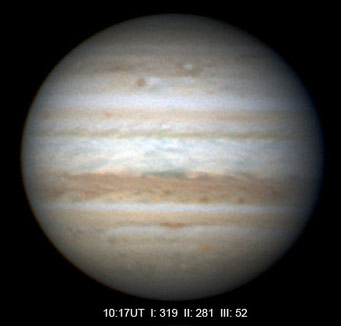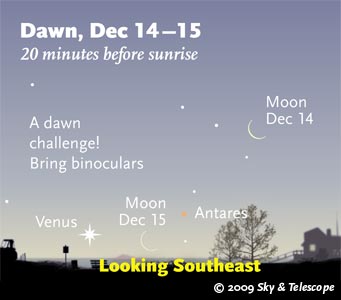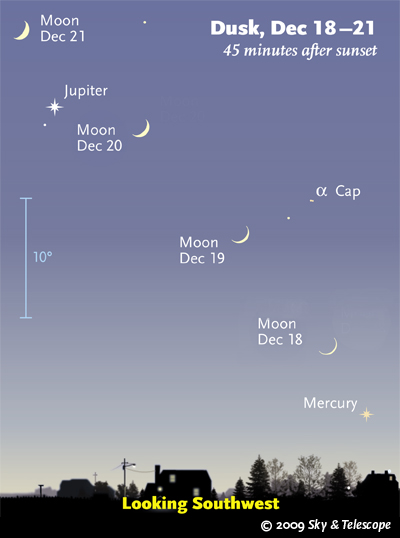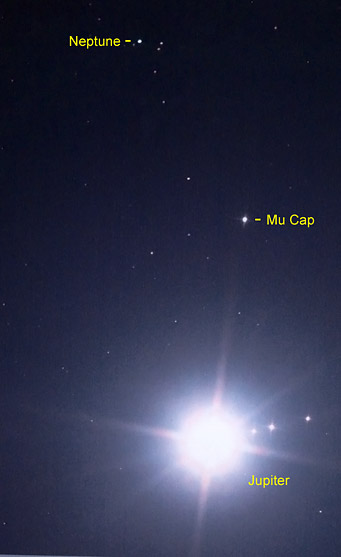Some daily events in the changing sky for December 11 – 19.
Friday, December 11

Jupiter continues to shrink as it moves westward toward conjunction; turn a telescope on it in late twilight while it's still at its highest. The North Equatorial Belt remains massively broad and dark, while the South Equatorial Belt has greatly faded and is divided into two narrow parts. Christopher Go in the Philippines took this image on December 14th at 10:17 UT, when System II longitude 281° was on the planet's central meridian. South is up.
Stacked-video images like this can show much more detail on a planet than the same telescope will reveal to the human eye.
Christopher Go
Saturday, December 12
Sunday, December 13
Bundle up very warmly; a sleeping bag helps, with an electric hotpad inside if you can manage it. Find a dark spot that's shielded from local lights and has an open view of the sky. Lie back on the ground or in a reclining lawn chair, and watch the stars overhead. With luck (and a moderately dark sky) you might see a meteor or two every minute on average. And there's no Moon to interfere this year! See our article.
The Geminids are bits of debris from the dead comet/asteroid 3200 Phaethon. The shower has been gradually gaining strength for the last century, and modeling of the meteor stream's orbit suggests that the Geminids will continue to improve in the coming decades.
Update: It was indeed a great year for the Geminids! The shower peaked at about 150 meteors per hour (the Zenithal Hourly Rate: the rate as would be seen under ideal conditions) during the late hours of December 13th Universal Time, according to this preliminary activity profile posted in near-real time by the International Meteor Organization.

Sunrise happens late this time of year, and if you look really low in the southeast before sunrise, you may still catch Venus. On the 15th the hairline crescent Moon will be even harder to spot than Venus, and maybe impossible. Use binoculars. (This scene is drawn for 40° north latitude and the longitudes of North America.)
Sky & Telescope diagram
Monday, December 14
Tuesday, December 15
Wednesday, December 16
Thursday, December 17

The waxing crescent Moon points the way to Mercury low in the cold twilight. The 10° scale as about the size of your fist held at arm's length.
Alan MacRobert
Friday, December 18
Saturday, December 19
Want to become a better amateur astronomer? Learn your way around the constellations. They're the key to locating everything fainter and deeper to hunt with binoculars or a telescope. For an easy-to-use constellation guide covering the whole evening sky, use the big monthly map in the center of each issue of Sky & Telescope, the essential magazine of astronomy. Or download our free Getting Started in Astronomy booklet (which only has bimonthly maps).
Once you get a telescope, to put it to good use you'll need a detailed, large-scale sky atlas (set of charts; the standards are Sky Atlas 2000.0 or the smaller Pocket Sky Atlas) and good deep-sky guidebooks (such as Sky Atlas 2000.0 Companion by Strong and Sinnott, the more detailed and descriptive Night Sky Observer's Guide by Kepple and Sanner, or the classic Burnham's Celestial Handbook). Read how to use them effectively.
Can a computerized telescope take their place? I don't think so — not for beginners, anyway (and especially not on mounts that are less than top-quality mechanically). As Terence Dickinson and Alan Dyer say in their Backyard Astronomer's Guide, "A full appreciation of the universe cannot come without developing the skills to find things in the sky and understanding how the sky works. This knowledge comes only by spending time under the stars with star maps in hand and a curious mind." Without these, "the sky never becomes a friendly place."
More beginners' tips: "How to Start Right in Astronomy".
This Week's Planet Roundup

Jupiter and Neptune had a previous conjunction last July. On the morning of July 9th, Bob Kimmel of Rockledge, Florida, took this image. Why are they so different in brightness? Jupiter is a bigger planet, but the main reasons are that Jupiter is closer to the Sun (so it gets illuminated more brightly) and also closer to Earth.
Kimmel used an 8-inch f/5 Newtonian reflector with a Canon D20a DSLR camera body on his back patio. This is an unguided 20-second exposure at ISO 3200.
Bob Kimmel
Mercury (magnitude –0.5) is having a good evening apparition. Look for it low in the southwest in twilight about 40 minutes after sunset.
Venus (magnitude –3.9) is very deep in the sunrise, as shown in scene at December 14 above. Venus appears lower each morning. Not until late this winter (Northern Hemisphere winter) will it emerge into view again, in the sunset.
Mars (magnitude –0.4, in Leo) rises around 8 or 9 p.m. local time, far below Castor and Pollux a bit north of east. A little later, twinkly Regulus rises about a fist-width beneath it. Mars and Regulus are very high in the south in the hours before dawn, now lined up horizontally.
In a telescope, Mars is 11 arcseconds wide and growing. The planet's north polar cap is in good view this season, bordered by a dark collar. Do you see other surface features? Identify them with the Mars map and observing guide in the December Sky & Telescope, page 57. Mars is on its way to opposition in late January, when it will be 14.1 arcseconds wide.
Jupiter (magnitude –2.2, in Capricornus) shines brightly in the south-southwest in twilight, and lower in the southwest later. It sets by 9 or 10 p.m.
Saturn (magnitude +1.0, in the head of Virgo) rises in the east around midnight or 1 a.m., and it shines high in the southeast before and during dawn. Its rings are still narrow, tilted 4.5° from edge-on to us.
Uranus (magnitude 5.8, below the Circlet of Pisces) is highest in the south during early evening.
Neptune (magnitude 7.9, in Capricornus) lurks closely in the background of Jupiter, which shines 11,000 times brighter. Nevertheless Neptune is detectable in good binoculars. Jupiter and Neptune are 1½° apart on the 11th. They come to conjunction, with Neptune 0.6° north of Jupiter, on the evening of December 19th. To identify Neptune (and Uranus), use our finder charts for these two faint planets.
Pluto is behind the glare of the Sun.
All descriptions that relate to your horizon or zenith — including the words up, down, right, and left — are written for the world's mid-northern latitudes. Descriptions that also depend on longitude (mainly Moon positions) are for North America. Eastern Standard Time (EST) equals Universal Time (also known as UT, UTC, or GMT) minus 5 hours.
To be sure to get the current Sky at a Glance, bookmark this URL:
http://SkyandTelescope.com/observing/ataglance?1=1
If pictures fail to load, refresh the page. If they still fail to load, change the 1 at the end of the URL to any other character and try again.
 0
0
Comments
You must be logged in to post a comment.